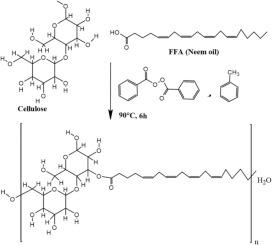可持续绿色印楝油基聚合物和纳米晶纤维素添加剂:合成、表征和润滑油性能
IF 6.2
1区 农林科学
Q1 AGRICULTURAL ENGINEERING
引用次数: 0
摘要
在润滑油行业中,使用由生物基材料生产的绿色添加剂已经引起了极大的兴趣。这些添加剂的特点是它们的无毒性质,成本效益,自然生物降解性和多种用途。目前的研究重点是合成印楝油衍生的均聚物,以及由印楝油与纳米晶纤维素(NCC)形成的共聚物。GC-MS分析确定了印楝油的脂肪酸组成,主要由油酸(~ 19 %)的存在主导,油酸为自由基聚合过程提供了关键的反应位点。这导致了同质聚合物和共聚物的形成。在此之后,FTIR证实了共聚物和均聚物的形成,因为在1550-1680 cm−1区域没有烯烃峰,而在纯印neem油中却存在。通过FTIR验证了纳米晶纤维素(NCC)的成功分离,表明在原料皮中可以观察到1500-1600 cm⁻¹ 附近的特征木质素峰和1735 cm⁻¹ 附近的半纤维素羰基峰被完全去除。TGA分析表明共聚物的热稳定性增强,在300°C时,共聚物的重量损失约为5 %,而在相同温度下,均聚物的重量损失为15 %。分析了合成添加剂在不同浓度下加入前后基础油的倾点和粘度指数。具体来说,聚合物(均聚物和共聚物)在浓度为1 %、2 %和3 % (w/v)时进行评估,而NCC在浓度为1 %和2 % (w/v)时进行评估。发现含有2 %共聚物的基础油是最佳的,其粘度指数最高,为111.1,倾点显著降低,为- 14°C。这些结果证实了合成的NCC(印度楝油的均聚物)和共聚物作为润滑油添加剂的有效性和适用性,特别是提高了润滑油的倾点和粘度指数。本文章由计算机程序翻译,如有差异,请以英文原文为准。

Sustainable green neem oil–based polymeric and Nanocrystalline cellulose additives: Synthesis, characterization, and performance in lubricating oils
There has been significant interest in the use of green additives produced from bio-based materials within the lubricant industry. These additives are characterized by their non-toxic nature, cost-effectiveness, natural biodegradability, and diverse applications. The current study focuses on the synthesis of a Neem oil-derived homo-polymer, as well as a copolymer formed from Neem oil with Nanocrystalline cellulose (NCC). GC-MS analysis identified the fatty acid composition of neem oil, which was primarily dominated by the presence of oleic acid (∼19 %), which offers crucial reactive sites for the process of free-radical polymerization. This led to the formation of both homo-polymers and copolymers. Following this, FTIR confirmed the formation of both copolymer and homopolymer due to the absence of the olefinic peaks in the 1550–1680 cm−1 region as opposed to their presence in the neat neem oil. The successful isolation of nanocrystalline cellulose (NCC) was validated through FTIR, which indicates a complete removal of the characteristic lignin peak around 1500–1600 cm⁻¹ and the hemicellulose carbonyl peak near 1735 cm⁻¹ , both of which are observable in the raw husk. The TGA analysis demonstrated the enhanced thermal stability of the copolymer, with about 5 % weight loss at 300°C in contrast to a 15 % loss for the homopolymer at the same temperature. The pour point and Viscosity Index of the base oil were analysed before and after the addition of the synthesized additives at different concentrations. Specifically, the polymers (both homo-polymer and copolymer) were evaluated at concentrations of 1 %, 2 %, and 3 % (w/v), whereas the NCC was assessed at 1 % and 2 % (w/v). The base oil containing 2 % copolymer was found to be optimal, yielding the highest Viscosity Index of 111.1 and a notably lower pour point of −14°C. These results confirmed the efficiency and applicability of synthesized NCC, a homo-polymer of neem oil, and copolymer as additives for lubricating oil to improve, specifically, its pour point and Viscosity Index.
求助全文
通过发布文献求助,成功后即可免费获取论文全文。
去求助
来源期刊

Industrial Crops and Products
农林科学-农业工程
CiteScore
9.50
自引率
8.50%
发文量
1518
审稿时长
43 days
期刊介绍:
Industrial Crops and Products is an International Journal publishing academic and industrial research on industrial (defined as non-food/non-feed) crops and products. Papers concern both crop-oriented and bio-based materials from crops-oriented research, and should be of interest to an international audience, hypothesis driven, and where comparisons are made statistics performed.
 求助内容:
求助内容: 应助结果提醒方式:
应助结果提醒方式:


